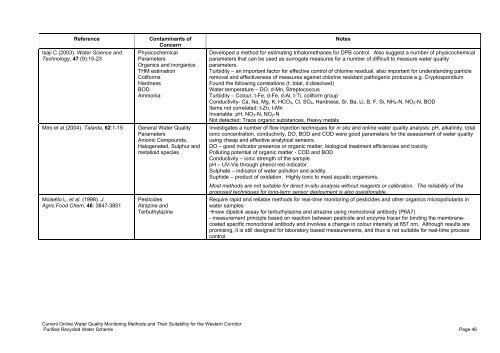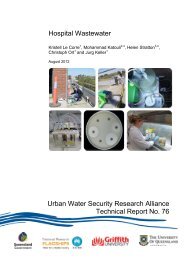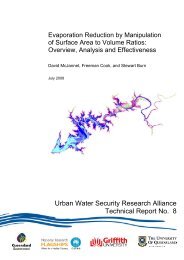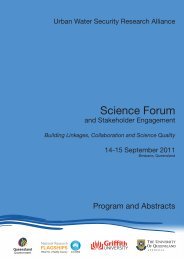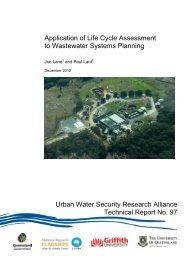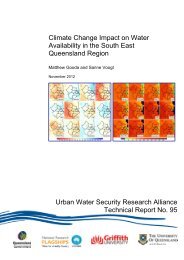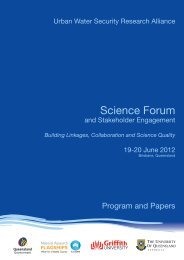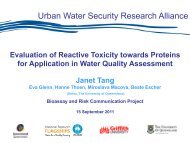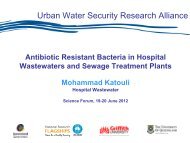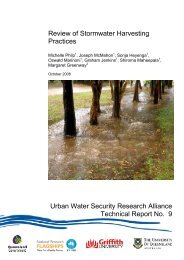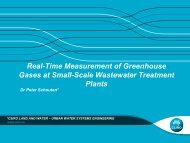ReferenceIsaji C (2003). Water Science <strong>and</strong>Technology, 47 (9):15-23Miro et al (2004). Talanta, 62:1-15Moisello L, et al. (1998). J.Agric.Food Chem, 46: 3847-3851Contaminants ofConcernPhysicochemicalParametersOrganics <strong>and</strong> inorganicsTHM estimationColiformsHardnessBODAmmoniaGeneral Water QualityParametersAnionic Compounds,Halogenated, Sulphur <strong>and</strong>metalloid speciesPesticidesAtrazine <strong>and</strong>TerbuthylazineNotesDeveloped a method for estimating trihalomethanes for DPB control. Also suggest a number of physicochemicalparameters that can be used as surrogate measures for a number of difficult to measure <strong>water</strong> <strong>quality</strong>parameters.Turbidity – an important factor for effective control of chlorine residual, also important for underst<strong>and</strong>ing particleremoval <strong>and</strong> effectiveness of measures against chlorine resistant pathogenic protozoa e.g. CryptosporidiumFound the following correlations (t: total, d:dissolved)Water temperature – DO, d-Mn, StreptococcusTurbidity – Colour, t-Fe, d-Fe, d-Al, t-Ti, coliform groupConductivity- Ca, Na, Mg, K, HCO 3 , Cl, SO 4 , Hardness, Sr, Ba, Li, B, F, Si, NH 4 -N, NO 2 -N, BODItems not correlated: t-Zn, t-MnInvariable: pH, NO 3 -N, NO 2 -NNot detected: Trace organic substances, Heavy metalsInvestigates a number of flow injection techniques for in situ <strong>and</strong> <strong>online</strong> <strong>water</strong> <strong>quality</strong> analysis: pH, alkalinity, totalionic concentration, conductivity, DO, BOD <strong>and</strong> COD were good parameters for the assessment of <strong>water</strong> <strong>quality</strong>using cheap <strong>and</strong> effective analytical sensors.DO – good indicator presence or organic matter, biological treatment efficiencies <strong>and</strong> toxicityPolluting potential of organic matter - COD <strong>and</strong> BODConductivity – ionic strength of the sample.pH – UV-Vis through phenol red indicator.Sulphate – indicator of <strong>water</strong> pollution <strong>and</strong> acidity.Suphide – product of oxidation. Highly toxic to most aquatic organisms.Most <strong>methods</strong> are not suitable for direct in-situ analysis without reagents or calibration. The reliability of theproposed techniques for long-term sensor deployment is also questionable.Require rapid <strong>and</strong> reliable <strong>methods</strong> for real-time <strong>monitoring</strong> of pesticides <strong>and</strong> other organics micropollutants in<strong>water</strong> samplesnew dipstick assay for terbuthylazine <strong>and</strong> atrazine using monoclonal antibody (P6A7)- measurement principle based on reaction between pesticide <strong>and</strong> enzyme tracer for binding the membranecoatedspecific monoclonal antibody <strong>and</strong> involves a change in colour intensity at 657 nm. Although results arepromising, it is still designed for laboratory based measurements, <strong>and</strong> thus is not suitable for real-time processcontrol.<strong>Current</strong> Online Water Quality Monitoring Methods <strong>and</strong> Their Suitability for the Western CorridorPurified Recycled Water Scheme Page 46
ReferenceRodriguez-Mozaz S et al. (2004).Journal of Chromatography A,1045 :85-92Cortina M et al (2007).Electroanalysis, 20 (1):54-60Eaton A <strong>and</strong> Briggs M (200x). NDMA-Analytical Methods Options for a newDisinfection By-Product, MontgomeryWatson Laboratories, Pasadena, CA91101Comparison of alternativeNitrosamine analyses for <strong>water</strong> reusesamples, Cheng. R <strong>and</strong> Andrews-Tate C, Hwang C, Guo Y, Grebel J<strong>and</strong> Suffer I, Funded by Water ReuseFoundationDavi M <strong>and</strong> Gnudi F (1999). WaterResearch, 33 (14) : 3213-3219Contaminants ofConcernEstrogens, Pesticides <strong>and</strong>Bisphenol APesticidesNDMANitrosamine (IncludingNDMA)Phenolic CompoundsNotesA multi-residue measurement system for classes of endocrine disrupting compounds has been developed e.g.estradiol, estrone, estriol, estradiol-17-glucuronide, estradiol diacetate, estrone-3- sulphate, ethynyl estradiol,diethylstilbestrol, atrazine, simazine, desethylatrazine, isoproturon, diuron, bisphenol A.Method uses a pre-concentrated LiChrolut RP-18 cartridge, followed by HPLC-MS analysis using APCI forpesticides <strong>and</strong> electrospray negative ionisation for estrogens <strong>and</strong> bisphenol A.It is not possible to monitor every substance in surface <strong>water</strong>; however it is necessary to define major targetareas of focus for effective barrier protection. Surface <strong>water</strong> chemistry exhibits changing chemistry <strong>and</strong>composition depending on environmental conditions.A single method of analysis for different classes of selected analytes would reduce the costs <strong>and</strong> time necessaryfor routine <strong>water</strong> <strong>quality</strong> analysis.Within the treatment process, it was found that the concentration of bisphenol A decreased progressively througheach treatment step. Study by these authors found that Bisphenol A was below the quantification limit.It is hypothesised that these variations also exist in the sewer catchmentUses amperometric sensor array combined with ANNs to determine pesticides in aqueous solutions. It wasevaluated on in river <strong>water</strong> before <strong>and</strong> after sewage treatment, <strong>and</strong> gave good results with low error. It showspotential for <strong>monitoring</strong> pesticides in the PRW system.-The original analytical method was developed by the Canadian Ministry of Environment (MOE) using solid phaseextraction technique with an Ambersorb resin, followed by isotope dilution GCMS. However many new <strong>methods</strong>have been developed to improve its reliability, sensitivity <strong>and</strong> simplicity. However there are no <strong>methods</strong> thatcurrently provide real-time continuous information on NDMA, which is required for the PRW system. The<strong>methods</strong> are still laboratory based <strong>and</strong> require calibration <strong>and</strong> st<strong>and</strong>ard reagents.- Report is an interlaboratory study which evaluated 5 <strong>methods</strong> for 8 types of nitrosamines including NDMA foraccuracy in different matrix types. Methods include :a) Micro Liquid-Liquid Extraction (MLLE)b) Ambersorb Solid Phase Microextraction (SPME) GC/MSc) Ambersorb Solid Phase Extraction (Amb SPE)d) Liquid-Liquid Extraction (LLE)Solid phase microextraction (SPME) is a low-cost method, however was not included in round robin testing.Results indicated that the Amb-Envi SPE <strong>and</strong> Amb SPE <strong>and</strong> traditional LLE (coupled with GC/MS) detectedNDMA at the minimum level of 2 ng/L <strong>and</strong> other nitrosamines between 2 <strong>and</strong> 4 ng/L.Phenolic compounds are problematic in drinking <strong>water</strong> due to <strong>their</strong> toxicity. Bisphenol A <strong>and</strong> somepolychlorinated biphenyls have the ability to mimic the activity of oestradiol.Method developed by EEC 75/440 determines total phenol using condensation with 4-aminoantipyrine in thepresence of potassium ferricyanide to form a coloured dye. However the method does not provide information onthe nature of the phenol. Interfering substances can also affect accuracy of the analysis.HPLC or GC-MS is more accurate <strong>and</strong> allows identification of individual phenolic compounds in the <strong>water</strong> matrixat low concentration. Precision <strong>and</strong> accuracy is also desirable.Chloro- <strong>and</strong> nitro-phenols listed in the EPA Federal Register, analysed by GC-MS by single ion <strong>monitoring</strong> (SIM)have rarely been detected <strong>and</strong> if so at levels less than 1 ug/L.There are no suitable rapid means of analysis.<strong>Current</strong> Online Water Quality Monitoring Methods <strong>and</strong> Their Suitability for the Western CorridorPurified Recycled Water Scheme Page 47


